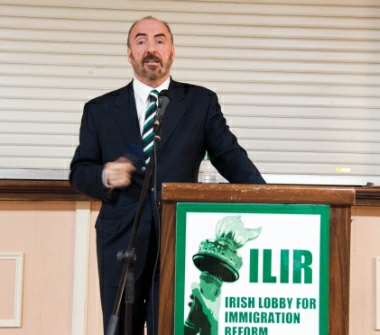She came here from Northern Ireland nearly 20 years ago just to visit her sister, and fell in love with America. And when she fell in love with the man who became her husband, a man from Belfast and, like her, here illegally, she found herself committed to a life in the shadows.
They now have children, American born, who can only see their Irish grandparents when they can come to the States. Because they’re “undocumented,” she and her husband can go back to Ireland, but they’d never be able to return to the US, the place they now call home.
“I haven’t been home to Ireland in 16 years,” she said. “When my husband’s mother died, he couldn’t even go to her funeral.”
For the 50,000 Irish in the US illegally, the story is much the same. But the new bipartisan immigration reform bill now before the US Senate could rewrite the ending, said Ciaran Staunton, president of the Irish Lobby for Immigration Reform, which has been on the stump since 2005 to bring undocumented Irish out of the shadows and open their path to citizenship of the country where they live, raise their children, and pay taxes.
Staunton was in Philadelphia on Wednesday night at a meeting called by the Philadelphia Gaelic Athletic Association, many of whose members are Irish born and depend on Irish players to fill out their rosters during summer’s 8 weeks of play on the fields of Cardinal Dougherty High School. In an impassioned speech sprinkled with Irish, he urged those who attended—about 50 people, including the woman from Northern Ireland—to call Pennsylvania’s GOP Senator Pat Toomey to urge him to vote yes on Senate Bill 744. (“Clearly his people dropped the ‘W’ when they came to America,” joked Staunton about the Rhode Island-born Toomey’s Irish forbears, referring to an alternate spelling of the name that may either be traced to a town in Galway or to the word in Irish meaning hill or burial mound.)
S 744 would legalize undocumented immigrants and establish 10,000 E visas, renewable work visas, for people from Ireland, both the republic and Northern Ireland. It needs 60 votes to pass the Senate, and though it has bipartisan support, including that of some prominent conservative Republicans including Marco Rubio, John McCain, and Lindsey Graham, passage is far from guaranteed, said Staunton. And its passage by the dog’s breakfast of personalities in the House is doubtful, though a major victory in the Senate could sway House members, some political observers are saying. Staunton said to send a strong message to the House, the bill’s chief supporter, NY Senator Charles Shumer, wants it to pass with more than 70 votes, not just the bare minimum.
Still, this week House Speaker John Boehner called the bill “laughable.”
On Wednesday night, no one was laughing. Even Staunton admitted it’s not a great bill. “It’s grand bargain and no one loves it,” he said. But it’s the only thing on the table right now.
Staunton recalled with some bitterness the quid pro quo act of the Bush Administration to give the Australians 10,000 E visas a year, limited to those with a college degree, for their military support in Afghanistan and Iraq and as a result of the Australia-United States Free Trade Agreement. “Yet they didn’t build roads, they didn’t build churches, and they didn’t build the democracy of America,” said Staunton.
The degree limitation is “a bit elitist as far as I’m concerned,” he said, noting that many of the Irish who come to the US are skilled “trades people.” At a New York fundraiser recently, he said, he was in a room of Irish-born millionaires “and none of them would be fit to come here under the Australian visas.”
One major stumbling block to passage of the bill is the insistence by some legislators that legalizing undocumented workers be linked to the protection of the border. Staunton said this brought him into rare agreement with NY Congressman Peter King who pointed out that there are already 11 million undocumented immigrants “inside our borders, and we need to know who they are.”
Immigration reform has some other strange bedfellows as well, including the US Chamber of Commerce, the labor unions, and the Catholic Bishops, though the church hierarchy has stopped short of Staunton’s wish that “they issue a statement from every pulpit.” And most political observers point out that the only reason there is an immigration reform bill on the table—albeit a shaky table—is the resounding support President Barack Obama received in his second term election from Latinos and other ethnic groups who have become alienated from the GOP in part because of its hard line stance on immigration.
The struggle will be difficult, but don’t count the bill down yet if supporters are willing to flood Toomey’s office with calls, said Jeff Dempsey, an aide to State Rep. Brendan Boyle, the son of Irish immigrants who is running for Congress in the 13th district, which includes Northeast Philadelphia and Montgomery County. (Boyle remains in Harrisburg to finish work on the state budget.)
You may think you’re “not effective,” Dempsey said. “But I’ve been on the other end of the phone” after a grassroots calling campaign and legislators take it very seriously. They understand “this is a groundswell, this is a constituency that we have to answer to,” he said.
The woman from Northern Ireland is hopeful, but still, when her parents called her, excited about the latest immigration reform push, “I told them not to get their hopes up,” she said. “They got excited when this came up a few years ago and all our great hopes fell. If this doesn’t work, it could be years before it comes up again.”
You can reach Senator Pat Toomey’s office at 215-241-1090 in Philadelphia or 610-434-1444 in Allentown.
View photos from the meeting here.


